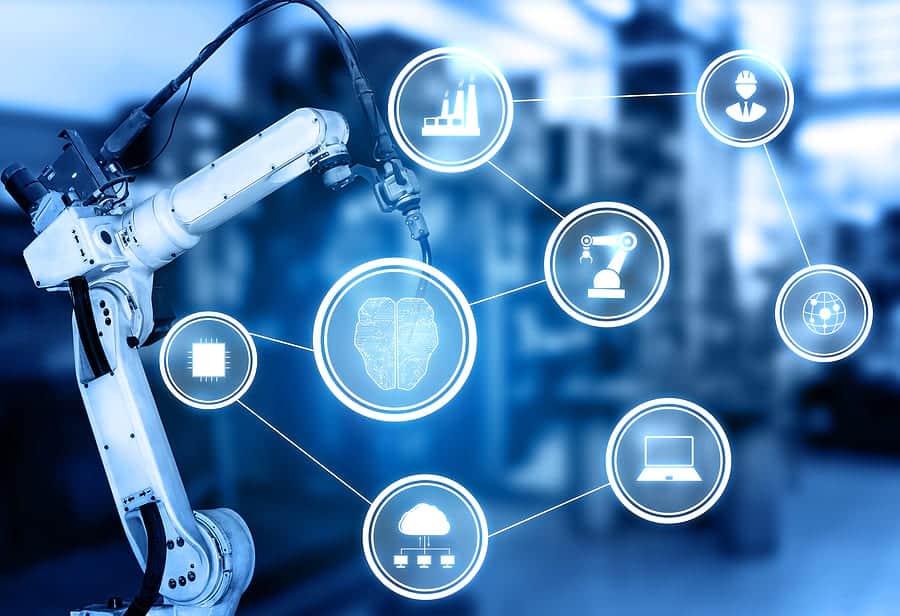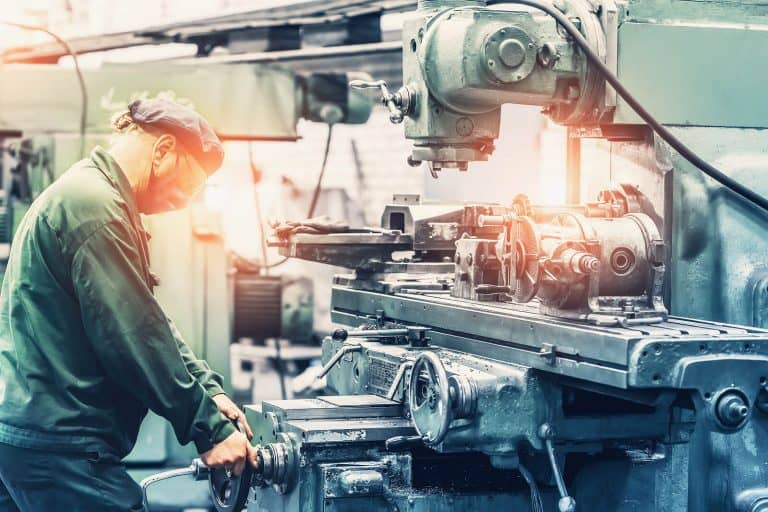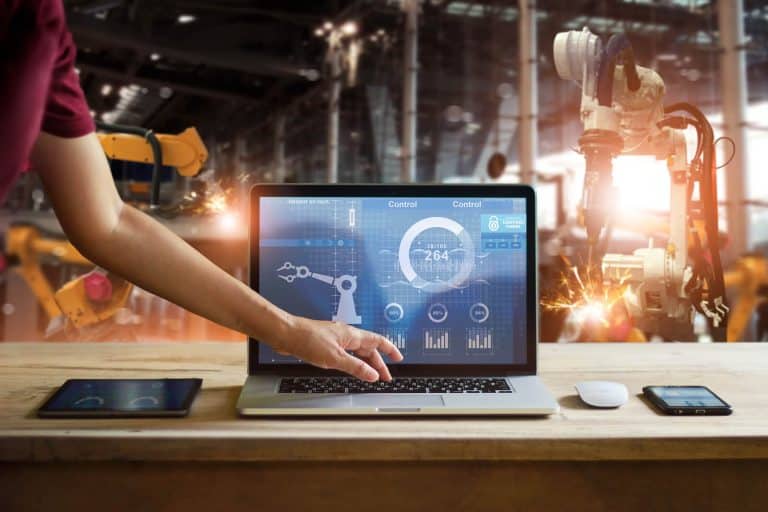The use of technology in manufacturing is not a new concept. After all, it was technological advancements and the development of new ideas that precipitated the first Industrial Revolution and subsequent evolutionary steps that advanced the manufacturing sector into the twentieth century and beyond.
Table of Contents
ToggleWe are currently in what observers call the Fourth Industrial Revolution, or Industry 4.0 — a condition in which the digitalization and process automation characteristic of advanced manufacturing technology is expanding manufacturers’ capabilities to unprecedented levels.
The Role of Technology in Manufacturing
Manufacturing technology provides the master tools of industry and processes that magnify the efforts of individual workers. The machinery and systems involved are used to perform specific operations on manufactured materials to produce durable goods or components and facilitate essential services or procedures.
Among the manufacturing technologies most commonly in use today are:
Design and Production Software: This includes systems for Computer-Aided Design (CAD), Computer-Aided Manufacturing (CAM), Computer Numerical Control (CNC), Direct Numerical Control (DNC), Programmable Logic Control (PLC), and Numerical Control (NC). Systems integration software and program optimization software are other production-related applications.
Tools and Processes for Material Removal: These include tools for turning, milling, drilling, grinding, broaching, sawing, and tapping. Electrical discharge machines (EDM), water jet cutting equipment, and laser process equipment are other machines in this category.
Material Forming Processes and Equipment: Major material forming processes include stamping, bending, joining, shearing, and hydro-forming. Presses and cold or hot forming equipment are some of the hardware employed.
Additive Processing Systems: These include 3D printing, laser sintering, and rapid prototyping equipment.
Tools for Holding Work: Not all manufacturing technologies are digital, and there’s still a need for chucks, fixtures, clamps, blocks, angle plates, and tooling columns.
Tooling Systems: Likewise, drills, taps, reamers, boring bars, dies, punches, and grinding wheels are still an essential part of certain manufacturing processes.
Material Handling Systems: This category includes a mix of mechanical and digital/electronic systems such as conveyors, automated wire-guided vehicles, die handling equipment, robots, pallet changers, and bar feed equipment.
Automated Systems and Cells: This general class of systems includes transfer machines, assembly systems, and Flexible Manufacturing Systems (FMS).
Automated Manufacturing
Much of the manufacturing technology associated with “Industry 4.0” has to do with automation, data exchange, digital technology, artificial intelligence (AI), machine learning (ML), and the Internet of Things (IoT).
Broadly speaking, an Automated Manufacturing System (AMS) is an interconnected system of material processing stations, capable of automatically processing a wide variety of parts simultaneously, under computer control. A material transport system is needed for interconnection, along with a communication network for integrating the various aspects of manufacturing.
A high degree of automation, integration, and flexibility are characteristic of automated manufacturing systems, which may incorporate several enabling technologies such as computer-aided design (CAD), computer-aided process planning (CAPP), computer-aided manufacturing (CAM), flexible assembly, flexible manufacturing, computer-aided testing (CAT), production planning and control, process technologies, robotics, and automated material handling.
Properly implemented, automation and robotics can reduce the time required to process an average production order through a factory, leading to lower production lead times and fewer bottlenecks. Automated manufacturing techniques have therefore proven valuable in a number of different industries.

Auto assembly plants have been using robots to automate various processes and to improve the efficiency of their automotive operations. In conjunction with data analytics, supply chain automation has made possible new plant production systems, such as Just-in-Time (JIT) production. In the past few decades, GM and Toyota have been at the forefront of automation, but more recently, companies like Tesla have also introduced the concept of super automated factories.
In aviation, automation serves to augment human labor in extreme or dangerous environments and ensure high safety standards. In the US, the Federal Aviation Administration (FAA) has laid down certain parameters for manufacturers to follow, which set out standards for the reliability and quality of systems and methods for reducing the risk of fatalities due to system failures.
Manufacturers in the electronics sector are increasingly relying on robotic process automation to meet production targets and satisfy the increasing demand for smartphones, consumer-level devices, televisions, and industrial electronics. In the electronics industry, there’s a need for high degrees of precision and minimal error. For this reason, many organizations are adopting collaborative robots (co-bots) — robotic systems designed to work in tandem with humans.
CNC Manufacturing
CNC stands for Computerized Numerical Control, and CNC manufacturing (often referred to as CNC machining) is a subtractive manufacturing process that typically employs computerized controls and machine tools to remove layers of material from a stock piece in order to produce custom-designed parts.
A CNC machine uses computers to control machine tools. A combination of computer-aided design (CAD) and computer-aided manufacturing (CAM) programs controls features such as feed rate, coordination, location, and speed of the tools. The CNC methodology frees up human labor and allows for precise results time after time.
The process is suitable for a wide range of materials, including metals, plastics, wood, glass, foam, and composites. It has applications in a variety of industries, including aerospace, where CNC automation enables the production of simple parts with high precision and high accuracy and provides a cost-effective means of fulfilling one-off and medium-volume production runs.
Manufacturing, Engineering, Technology
Within the context of Industry 4.0, the lines between manufacturing, engineering and technology are sometimes blurred. This occurs in a number of key areas, including:
Cyber-Physical Systems
Cyber-physical systems are systems that integrate computer, networking, and physical processes, and in which embedded computing technologies control and monitor processes in real-time. In general, the computer system monitors a process and identifies areas where change is required, and the physical system reacts accordingly.
Additive Manufacturing
More commonly known as 3D printing, additive manufacturing is a computer-controlled process enabling the creation of three-dimensional objects from materials deposited in layers. Additive manufacturing processes reduce material wastage and allow the production of a diverse range of products and components, often with the assistance of computer-aided design (CAD) or 3D object scanners.
Augmented Reality (AR) And Virtual Reality (VR)
Augmented reality or AR technology displays digital content as an overlay on objects in the real world. This allows for the instantaneous visualization of product details or the superimposition of data or plans onto physical components and machinery. In manufacturing, AR may be used to overlay text or statistics, for instance, enabling workers to monitor the running temperate of a piece of equipment without touching it.
Virtual reality (VR) technology enables programmers to create immersive environments that don’t involve a person’s immediate surroundings. This enables manufacturers to create realistic simulations of products and processes in a variety of settings. VR also has applications for training and skills acquisition. For example, virtual health and safety training can put candidates through emergency procedures without requiring an individual to involve themselves in something potentially harmful.
Computer Numerical Control (CNC)
Computer Numerical Control or CNC manufacturing technology makes it possible to regulate and remotely control machining tools or items such as 3D printers. Modern CNC systems allow the design and manufacture of mechanical parts to be highly automated.
Tech Manufacturing
Tech manufacturing or high-tech manufacturing has its focus on high-end technology and includes the manufacturing of personal and commercial computer products. Companies working in this sector also manufacture the elements that make the computers run, such as circuit boards, capacitors, electron tubes, and fiber optic cables. Typically, the machinery used to fabricate and build the computers, circuit boards, and other components are made by high-tech manufacturers in the same industry.
Incidentally, there’s a company called Tech Manufacturing LLC, which operates out of Wright City, Missouri. It started as a single person aerospace machining company in 1956, run by a retired McDonnell Douglas employee working out of a 3 car garage in South St. Louis. Today, Tech Manufacturing specializes in the CNC precision machining of complex, thin-walled, monolithic, hard metal, and aluminum structural aerospace parts for commercial, military, and business airframes.





